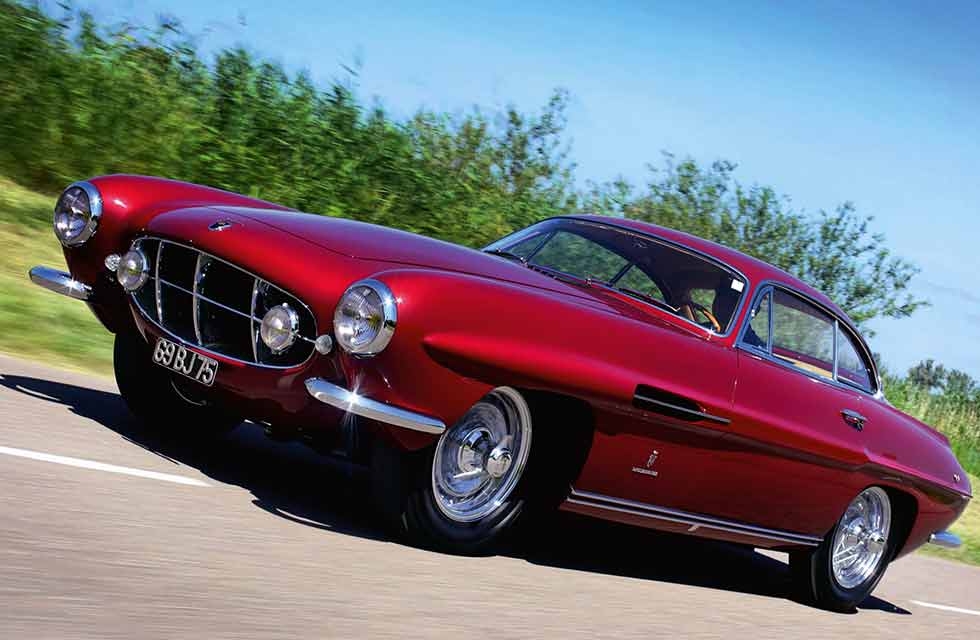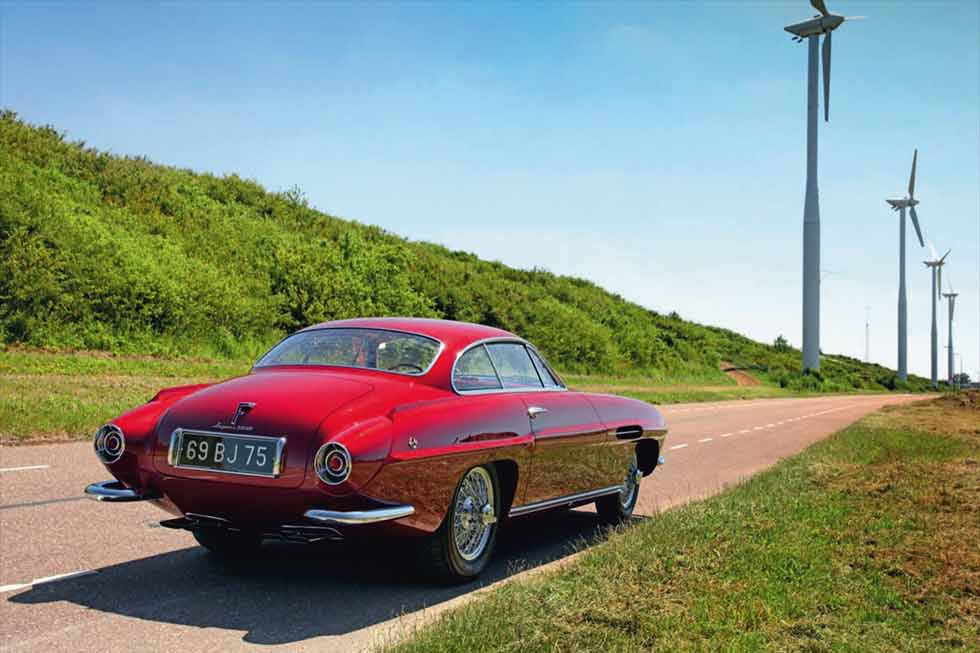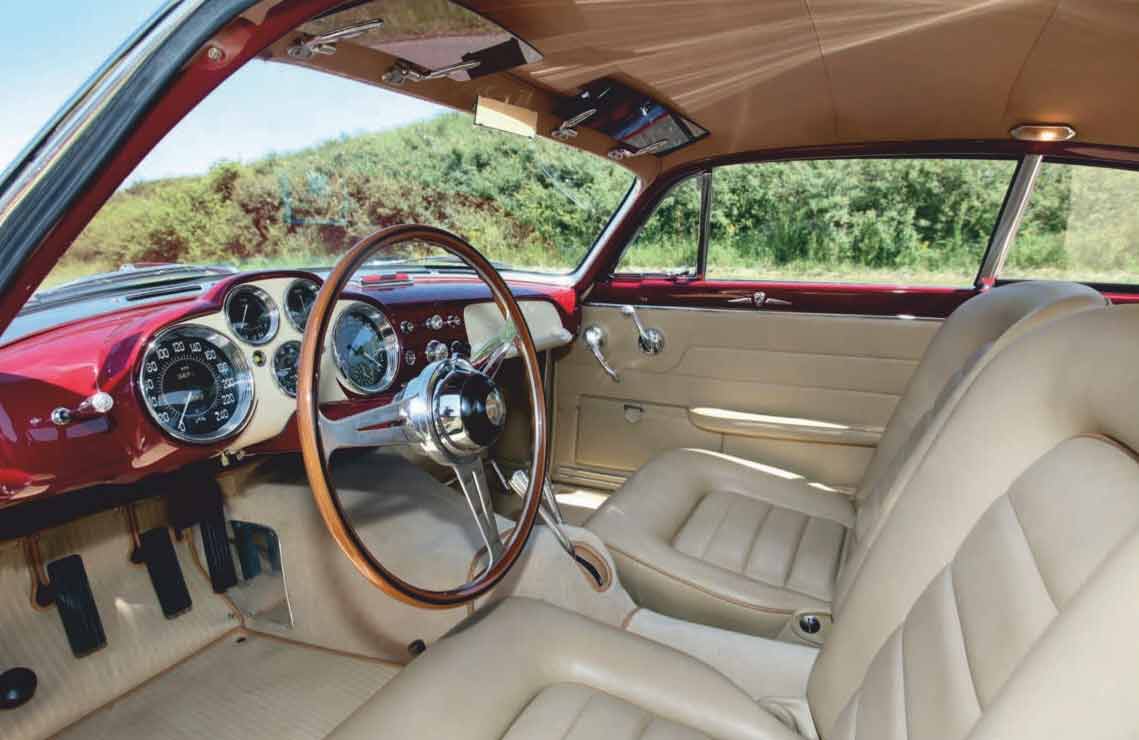
Jet-Age Jaguar – Mick Walsh gets a close encounter of the wheeled kind, with the gorgeous Ghia-bodied XK120 Supersonic. When one of Italy’s finest coachbuilders redefined the Jaguar with a style born out of aviation, it landed upon the XK120 Supersonic by Ghia. Words Mick Walsh. Photography James Mann.
GHIA’S BREATHTAKING JAGUAR SUPERSONIC
Although many Italians are enthusiastic Anglophiles, it’s hard to imagine anyone going to great expense to combine an English body with a Latin chassis. But the reverse union makes sense, as the spectacular 1954 Jaguar XK120 Supersonic proves. On one of the hottest days of the year it’s difficult to look chic is this burgundy GT, but cruising around Paris 60 years ago it must have been the coolest of cats. With shapely, sleek Italian skin wrapped tightly around the tuned XK120 chassis, and few vents to free the hot air from the 3.4-litre ‘six’, you’re guaranteed to cook inside the stylish but cramped cabin.

Even for my short build it’s a tight squeeze, with legs bent around the broad, wood-rimmed three-spoke steering wheel and the shell-like XK pointed boss targeting my chest. If the driver is baking, the dashboard is ice-cool, its two-tone paint matching the plush trim. The neat binnacle groups five gauges, including a 6000rpm rev counter and 240kph speedo.
‘Only the XK doorhandles, vertical bars within the grille and unique badging give clues to this Italian’s Coventry connection’
There’s no mistaking the origins once on the move. The Burman steering is low-geared and light, the Moss gearbox action slow and methodical, and the drum brakes uninspiring. With around 200bhp, the rorty XK straight-six delivers torque and pace with a howl, but through the bends its hefty forward weight results in understeer when hurried. Narrow wheels and a pronounced overhang create an ungainly lean through turns, but its launch out of corners is impressive. As with all XKs the ride is good, and this Ghia rebody has a quality creak- and groan-free feel.

On the flat Dutch landscape, the Supersonic looks dazzling in the high sun and everyone stops to admire it. In a country where wind energy has a long tradition, it seems appropriate that the car arrives into a towering turbine farm: this sleek, low GT shape evolved from wind tunnel tests carried out by Giovanni Savonuzzi, a freelance design engineer who combined aviation theory with his automotive dreams. The Supersonic originated from a one-off design by Virgilio Conrero, commissioned by wealthy Swiss enthusiast Robert Fehlmann to compete in the 1953 Mille Miglia. The basis was an Alfa Romeo 1900 engine but with a special tubular chassis featuring Fiat 1400 front axle and Lancia Aurelia transaxle and rear suspension. For the bodywork Conrero enlisted his close friend Savonuzzi, who had just left Cisitalia. Several scale models were made and, as with many of his previous GT and speed record projects, Savonuzzi tested the shape in the wind tunnel at the Politecnico di Torino.
The body was made by Ghia in its Turin workshops and featured many of the signature details carried through the Supersonic line, such as the elongated nose and tail enhanced by the low roofline and long side moulding. The taillight design clearly shows the jet-age influence that was fashionable at the time on both sides of the Atlantic, while novel features included flushfitting pushbutton doorhandles and a Perspex top that followed the roof profile.

Painted white, the prototype Conrero Supersonic made its debut at the 1953 Turin Salon. With hubcaps removed and Geneva registration plates fitted, the coupé was entered into the 2-litre Sport class of the Mille Miglia and roared up on to the Brescia start ramp in darkness for its 4:53am start on 26 April, giving it the race number 453.
On the event, few outside Brescia saw the sensational Supersonic because it never reached Rome – Fehlmann and co-driver G Vuille had a major accident that resulted in a devastating fire. While the burnt-out aluminium body was beyond salvation, the chassis survived. Fehlmann commissioned Conrero to rebuild the car, but with a new Giovanni Michelotti design and a removable Perspex hardtop. With a hot twinplug head fitted, it was unsuccessful on the 1954 Mille Miglia. Later, with the top removed, the Conrero Alfa became a successful hillclimb car and is a now regular on the modern Mille Miglia.
Because of the excitement the Conrero Supersonic had created, Ghia decided the body style should continue with a series of bespoke coupés based on the Fiat 8V. In October at the Paris Salon, the second Supersonic was voted the most beautiful car. Savonuzzi started his career in the aeronautical division of Fiat, and as Ghia’s new technical director he no doubt played a key role instigating the Otto Vu for the new series. The first car, chassis 106.000035, was ordered by Paul Farago and was exported to America, where it created a similar stir and featured extensively in the automotive press. Chrysler had already established links with Ghia through Virgil Exner, its design chief who had been impressed by pictures of the Supersonic. Once Exner had heard of the burgundy 8V’s arrival Stateside, he arranged for the Italian exotic to be loaned to Chrysler, where it inspired a series of Ghia-built show cars including the Savonuzzistyled De Soto Adventurer II.
Later owned by Paul Lazaros, an engineer and machinist, the first 8V Supersonic was stored for more than 55 years before the amazingly original beauty – with just 17,000 miles on the clock and still on its original Pirelli Cinturato tyres – appeared on the concours scene in 2010. Two Fiat Supersonics were also ordered by Lou Fageol, director of the Twin Coach Company and a champion hydroplane racer.
Fageol entered his two Supersonics into the 1955 Pebble Beach Concours, one of which was later bizarrely customised with prominent fins (rumoured to be made of plywood), triple-deck bumpers, a Continental kit and a two-tone paint scheme. The sexagenarian later used this car as his daily transport, but with the Fiat 8V engine replaced by a fuel-injected Corvette motor. Ghia had hopes of building 50 Supersonics on the 8V chassis, but the costly 2-litre had limited appeal and final production numbers vary between seven and 15, depending who you ask.
Outside Italy the Fiat Otto Vu was little known, which may have led to other marques being selected as the basis for the sensational Supersonic styling. In France, wealthy Lyon based millinery and lingerie manufacturer Joseph Malpelli had been smitten by an 8V Supersonic at the Grand Palais. A Jaguar enthusiast, Malpelli already owned an XK120 coupé bought new from the Paris Jaguar dealer, Charles Delecroix at Royal Elysées. Because the factory wouldn’t supply XKs in chassis form for coachbuilding, custom projects had to originate from complete car orders, so Malpelli decided to have his XK transformed into a Supersonic and even put a deposit on a second Ghia conversion order through Delecroix. As well as the body rework, the engine was tuned in Italy, with Conrero enlisted to fit triple Webers in place of the standard SU carburettors.
Chassis 679768 was completed in 1954 and shown in both Paris and London, as well as at several major concours d’élégance competitions including Montreux and Cannes. The second Jaguar XK120 Supersonic, chassis 675090, was eventually completed and differed in styling details with a Ferrari-type eggcrate-style grille, a prominent bonnet bulge and a two-tone paint scheme of silver roof over metallic blue main body with no side vents.
A third XK Supersonic was built and sold to Switzerland but has since vanished. For many years, historians believed four Jaguar-based Supersonics were built, but French automotive historian Christian Descombes discovered that Malpelli had switched the registration of his first car from 69 BJ 75 to 66 BJ 75 simply by turning over the second number to avoid the smutty jokes from concours spectators.
Malpelli’s fashion business took a dive in the mid-’50s and he left France without fully paying his bill with the Paris dealer. The first Supersonic remained with Royal Elysées through the ’60s, but when Jaguar set up a factory dealership and started importing its own stock to France, Delecroix’s firm was hit hard and closed its doors in ’1969. The stock, including this low-mileage Supersonic, was acquired by Philippe Renault, a well-known Jaguar enthusiast. He sold the car to Roland Urban, who displayed it in his special-bodied Jaguar collection at Montlhéry.
In 1994, with just 9400km on the clock, the Supersonic was bought by Jean-Claude Ferchaud and renovated by French Jaguar specialist Atelier Sontrop. The car was resprayed, but its original Ghia upholstery from 1953 was retained, and in the 1995 Concours Automobiles Classiques et Louis Vuitton at the Parc de Bagatelle in Paris it was again a winner as six Supersonics were united in a special class. In 2015 the Supersonic XK left France for the first time in six decades to be auctioned by RM Sotheby’s during Monterey Car Week. It sold for $2.1million to a Thai collector.
Although the car was in sound original condition, its new owner had aspirations of Pebble Beach glory and experienced Fiat Supersonic rebuilder Strada e Corsa in The Netherlands was enlisted. Despite the car being cosmetically tidy, a total stripdown was required and the bare metal body was sent back to Italy to Carrozzeria Quality Cars near to Padua.
When the owner changed his plans to reveal the Supersonic three months earlier, in May 2019 at Villa d’Este, Lennart and Jurriaan Schouwenburg’s team pulled out all the stops to complete the car. Once the body was finished, the car was transferred to Strada e Corsa for assembly and detailing. The interior was intact, but it was decided to copy it for a full retrim and set the original aside. “This was the most complete Supersonic we’ve rebuilt and so was relatively straightforward,” recalls Lennart Schouwenburg. “But the time was very tight.”
While the cabin features many differences from the earlier Fiat 8V Supersonics, the bodywork is essentially the same, hammered out by Ghia’s talented artisans using the same body buck. “Ghia workmanship is among the best of the classic coachbuilders,” adds Schouwenburg. Only the XK doorhandles, triple vertical bars within the grille and unique badging give clues to this Italian’s Coventry connection.
At Villa d’Este the Supersonic was pipped to the class win by another Ghia creation, the wild Abarth 205 Sport 1100 that coincidentally took its bow at the same 1953 Turin show as the original Conrero prototype. What Sir William Lyons made of the coachbuilt XK wonder isn’t recorded, but of all the attempts to restyle the brilliant production original, none matched the spectacular Supersonic. While others quickly looked dated and contrived, Savonuzzi’s 1953 design was fitted 10 years later on to a Cobra 427 – chassis CSX3055 – after a Supersonic 8V was discovered in a scrapyard. No doubt its talented designer would have been amused by this 7-litre, 160mph rocket.
Thanks to Strada e Corsa (stradaecorsa.com)
Above: Conrero 1900 Coupé prototype, the forebear of every Supersonic produced, fulfilling its raison d’être by contesting the Mille Miglia in ’1953. Rushed to be ready, it crashed out early.
Clockwise from main: Jaguar wheels remain in the deep arches; F denotes French heritage; Marchal lights punctuate grille; Jaguar doorhandles are carried over; Nardi wheel.
The Supersonic produces lots of roll through the corners, and the steering loads up for an involving driving experience – and plenty of understeer.
Clockwise from main: long nose and rounded rump are characteristic of the Supersonic style; jet-thruster tail-lights; slender quad exhausts; Jaguar badge sits proud on the nose; sublime XK straight-six engine. Main: Jaguar XK120 interior was retrimmed in beige leather by Ghia, rather than replaced. Inset: similar De Soto Adventurer II was created for Chrysler by Ghia.
FATHER OF THE SUPERSONIC
Born in Ferrara in the Emilia-Romagna region in 1911, the talented Giovanni Savonuzzi designed some of the most advanced GTs to contest the Mille Miglia, an event he would no doubt have witnessed during his 20s because the route regularly ran through his home town. After studying engineering in Turin, he had a diverse career split between aviation and automotive employment. In 1940 he joined Fiat’s aircraft engine division but, almost as a hobby, he made car styling models in his spare time. Although an engineer first, Savonuzzi had a strong aesthetic eye and many of his designs, as with Jaguar’s Malcolm Sayer, evolved from wind-tunnel tests.
Savonuzzi switched from aviation to cars in 1945 when he replaced Dante Giacosa as technical manager at Cisitalia. As well as completing the unfinished D46 monoposto, Savonuzzi designed and developed Cisitalia’s first sports car, the 202. From the first 1947 spider raced by the great Tazio Nuvolari to a remarkable second on the Mille Miglia, through to the finned coupé streamliners built by Alfredo Vignale, Savonuzzi’s designs clearly showed the influence of aerodynamics.
The versatile engineer also produced styling sketches for Pinin Farina that look very close to the final 202 road car, regarded as one of the most beautiful cars in the world and featured in the New York Museum of Modern Art as ‘sculpture in motion.’ The ever-dapper Savonuzzi, who always wore a tie, was also a highly regarded driver and regularly tested his designs, which earned the respect of fellow engineers and mechanics.
When Cisitalia founder Piero Dusio announced ambitious plans to build a Grand Prix challenger, Savonuzzi lost faith and set up his own company, SVA, in Turin. Working as a freelance designer he developed the Supersonic style together with his own stillborn racing car project, but in 1954 he joined Ghia full-time as technical director. Among his first projects was an Alfa Romeo 1900 Super Sprint that featured many Savonuzzi details, such as floating headlights with chrome turbine-like nozzles, and a roof style that carried through to the Volkswagen Karmann Ghia. With the Turin-based carrozzeria he worked with Luigi ‘Gigi’ Segre, who had started a collaboration with American manufacturers that led to such innovative designs as the Ford Futura, Ghia Gilda and Ghia Ferrari 210 Supersonic. Savonuzzi was also involved with Count ‘Johnny’ Lurani’s Nibbio II record car, which was developed in the Politecnico di Torino’s wind tunnel.
Savonuzzi relocated to America in ’1957 to join Chrysler as chief engineer for turbine research. He was closely involved with car and truck applications that climaxed in the brilliant but ultimately fruitless 1963 Turbine Car. In 1969 Savonuzzi returned to Italy and rejoined Fiat as director of the Orbassano Research Centre and as a consultant for Fiat Aviation. He became a professor at the Politecnico di Torino in retirement and died in ’1987. Yet few know of his connection with the Supersonic. A tribute at a concours or in the Museo Nazionale dell’Automobile is long overdue. Just imagine the line-up, from Cisitalia Aerodinamica to Ghia Gilda concepts.






